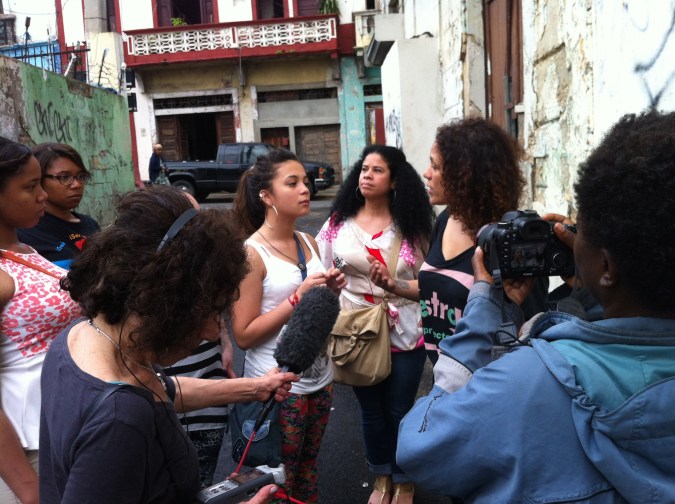At a suicide prevention program in the Bronx, author and filmmaker Raquel Cepeda came face to face with a problem plaguing Latina teens across the country. While visiting the Life is Precious counseling program, Cepeda stood in front of girls as young as 12, all of whom had seriously considered suicide. According to a survey conducted by the Center for Disease Control in 2015, Latina teens have the highest rate of suicide attempts of all adolescent groups in the United States. In New York City alone, it’s the second leading cause of death for Latina adolescents.
Cepeda had been invited to speak during a career day, but after hearing the girls’ stories, it reminded her so much of her own experience growing up in New York that she felt compelled to follow their journeys in her documentary Some Girls. “I was basically listening to someone tell me my own story,” Cepeda said. “Some of the issues they were having – reconciling their American selves with their Latinx selves – it really shocked me seeing how little things had changed from when I was their age.”
The documentary, filmed over the course of five years, delves into the lives of four Latinas in the Life is Precious program as they connect with their heritage. From the beginning, the viewer is brought directly into the bedrooms of these young girls as they open up about the personal trauma that brought them to Life is Precious in the first place. Cepeda narrates the film, deftly alternating between her own experiences and plainly explaining truths about Latinx history. In raw and close-up shots, the girls talk about the bullying and body issues that led them down the path of self harm.
Years before filming, Cepeda wrote about her own journey of self discovery in her acclaimed 2013 biography Bird of Paradise: How I Became Latina. In the book, she explains how the loss of her father spurred her to discover the truth about her heritage. In her documentary, she helps the girls do the same. In order to find out more about where they come from, the girls take DNA tests and discover their Central and South American roots before embarking on a journey to the Dominican Republic.
Former Life is Precious program coordinator Beatriz Coronel (who also accompanied the girls on their trip) said one of the main risk factors that leads to suicidal ideation in Latinx youth is the disconnect between their own culture and what they learn in school or see in media. “How do you get to connect with your community and roots if you never leave?” Coronel said. “The history that’s being taught in school is not their own, so it was important for them to be exposed to a more resilient history of ancestors that were able to overcome the obstacles that they faced.” By finding out more about their history, Coronel and Cepeda hoped to give the girls – some of whom had never left the Bronx – a chance to understand who they are.
With establishing shots that showcase the vibrancy of the DR’s landscapes, the doc shifts in tone as the girls begin to feel empowered by their history. They visit the site of a crucial slave rebellion at a historic sugar mill and the Cueva de las Maravillas with its walls richly decorated in indigenous Taino artwork. It’s here that the viewer can really begin to see the impact this trip is having. The subjects are this documentary’s greatest strength. With bare bones editing, their emotional transformation takes centerstage.
In the car following the visit to the cave, Ashley shares lyrics she wrote with the group after their visit. Everyone around her smiles as she raps “This cave is really my empowerment/I’m descended, it’s even in my documents/We had the will to survive/That should mean that I should try.” Throughout her impromptu performance, it’s obvious that she’s drawing on the strength of her ancestors and the new history she’s learned.

After returning to the U.S., Coronel said the transformation the girls underwent was tangible. “The girls became more empowered, developed strengths, became more confident,” she said. “They were able to articulate more who they were especially when they found out what other people had experienced. They were able to identify with their history.”
After filming, the Some Girls team partnered with Harvard’s Graduate School of Education to create companion curriculum that would allow teachers to incorporate the documentary in their lesson plans. Soraya Ramos, part of the group that developed the curriculum, said she felt it was important to give teachers a way to address important multicultural issues like those addressed in the documentary. “If we’re not seeing ourselves in the classroom, not hearing our stories, it feels like we’re not important,” Ramos said. “That’s the narrative we’re trying to change. These conversations aren’t happening in classrooms and they should be.”
By making the movie available to stream and the curriculum free to download, Cepeda hopes to have a wider impact on Latinas across the country. “We’re a marginalized subset of a marginalized group, so it’s important to always remind our young women that somebody out there has their back, someone cares,” Cepeda said. “I can’t speak to every Latinx person in the country, but I’m trying to reach as many as I can with this film.”
Some Girls is available to rent or buy here.
If you or someone you know is in crisis and needs help, call the toll-free, 24-hour hotline of the National Suicide Prevention Lifeline at 1-800-273-TALK (1-800-273-8255) to be connected with a trained counselor at a suicide crisis center nearest you.




